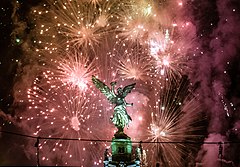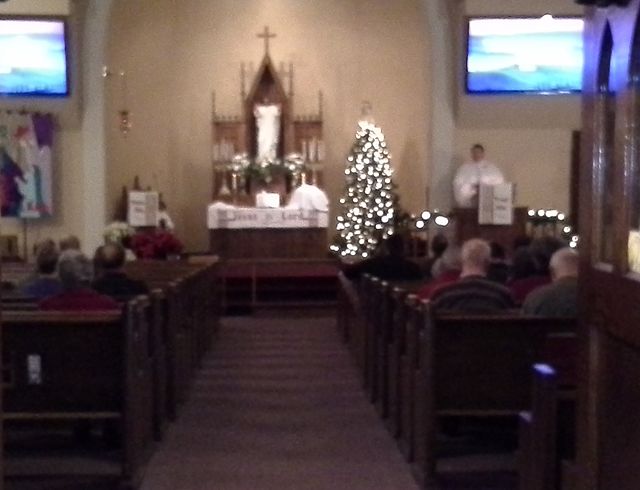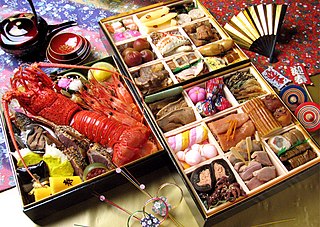Loading AI tools
First day of the year in the Gregorian calendar; 1 January From Wikipedia, the free encyclopedia
In the Gregorian calendar, New Year's Day is the first day of the calendar year, 1 January. Most solar calendars, such as the Gregorian and Julian calendars, begin the year regularly at or near the northern winter solstice. In contrast, cultures and religions that observe a lunisolar or lunar calendar celebrate their Lunar New Year at varying points relative to the solar year.
| New Year's Day | |
|---|---|
 Fireworks in Mexico City for the Celebration of the New Year in 2013 | |
| Observed by | Users of the Gregorian calendar |
| Type | International |
| Significance | The first day of the year in the Gregorian calendar |
| Celebrations | Making New Year's resolutions, church services, parades, parties, sporting events, fireworks,[1] drone light shows |
| Date | 1 January |
| Next time | 1 January 2026 |
| Frequency | Annual |
| Related to | |
In pre-Christian Rome, under the Julian calendar, the day was dedicated to Janus, god of gateways and beginnings, for whom January is also named. From Roman times until the mid-18th century, the new year was celebrated at various stages and in various parts of Christian Europe on 25 December, on 1 March, on 25 March and on the movable feast of Easter.[2][3][4]
In the present day, with most countries now using the Gregorian calendar as their civil calendar, 1 January according to Gregorian calendar is among the most celebrated of public holidays in the world, often observed with fireworks at the stroke of midnight following New Year's Eve as the new year starts in each time zone. Other global New Year's Day traditions include making New Year's resolutions and calling one's friends and family.[1]


The ancient Babylonian calendar was lunisolar, and around the year 2000 BC[5] began observing a spring festival and the new year during the month of Nisan, around the time of the March equinox. The early Roman calendar designated 1 March as the first day of the year.[6] The calendar had just 10 months, beginning with March. That the new year once began with the month of March is still reflected in some of the names of the months. September through to December, the ninth through to the twelfth months of the Gregorian calendar, were originally positioned as the seventh through to the tenth months. (Septem is Latin for "seven"; octo, "eight"; novem, "nine"; and decem, "ten") Roman mythology usually credits their second king Numa with the establishment of the two new months of Ianuarius and Februarius. These were first placed at the end of the year, but at some point came to be considered the first two months instead.[7]
The January kalend (Latin: Kalendae Ianuariae), the start of the month of January, came to be celebrated as the new year at some point after it became the day for the inaugurating new consuls in 153 BC as a result of the rebellion in Hispania which began the second Celtiberian War. Romans had long dated their years by these consulships, rather than sequentially, and making the kalends of January start the new year aligned this dating. Still, private and religious celebrations around the March new year continued for some time and there is no consensus on the question of the timing for 1 January's new status.[8] Once it became the new year, however, it became a time for family gatherings and celebrations. A series of disasters, notably including the failed rebellion of M. Aemilius Lepidus in 78 BC, established a superstition against allowing Rome's market days to fall on the kalends of January and the pontiffs employed intercalation to avoid its occurrence.[9][10]

The Julian calendar, proposed by Julius Caesar in 46 BC, was a reform of the Roman calendar. It took effect on 1 January 45 BC, by edict. The calendar became the predominant calendar in the Roman Empire and subsequently, most of the Western world for more than 1,600 years. The Roman calendar began the year on 1 January, and this remained the start of the year after the Julian reform. However, even after local calendars were aligned to the Julian calendar, they started the new year on different dates. The Alexandrian calendar in Egypt started on 29 August (30 August after an Alexandrian leap year). Several local provincial calendars were aligned to start on the birthday of the Emperor Augustus, 23 September. The indiction caused the Byzantine year, which used the Julian calendar, to begin on 1 September; this date is still used in the Eastern Orthodox Church for the beginning of the liturgical year.
At various times and in various places throughout mediaeval Christian Europe, the new year was celebrated on 25 December in honour of the birth of Jesus; 1 March in the old Roman style; 25 March in honour of Lady Day (the Feast of the Annunciation, the date of the conception of Jesus); and on the movable feast of Easter.[2][4]

Christians of various denominations (Catholics, Lutherans, Anglicans, and Moravians, among others) often attend a watchnight service (also known as a Watchnight Mass if Holy Communion is celebrated) on the night of New Year's Eve and this liturgy concludes in the morning of New Year's Day. Watchnight services provide the opportunity for Christians to review the year that has passed and make confession, and then prepare for the year ahead by praying and resolving.[11] The services often include singing, praying, exhorting, preaching, and Holy Communion.[12][13]
As a date in the Christian calendar, New Year's Day liturgically marked the Feast of the Naming and Circumcision of Jesus, which is still observed as such in the Lutheran Church, Anglican Church,[14][15] the Ambrosian section of the Catholicism, the Eastern Orthodox Church (Julian calendar, see below) and in Traditional Catholicism by those who retain the usage of the General Roman Calendar of 1960. The mainstream Roman Catholic Church celebrates on this day the Solemnity of Mary, Mother of God.[16] In Western Christianity, the Feast of the Naming and Circumcision of Jesus Christ marks the eighth day (octave day) of Christmastide.[17]
Among the 7th-century pagans of Flanders and the Netherlands, it was the custom to exchange gifts at the winter solstice. This custom was deplored by Saint Eligius (died 659 or 660), who warned the Flemish and Dutch: "(Do not) make visuals, [little figures of the Old Woman], little deer or iotticos or set tables [for the house-elf, compare Puck] at night or exchange New Year gifts or supply superfluous drinks [another Yule custom]."[18]

On the date that Christians celebrated the Feast of the Circumcision of Christ (January 1), they exchanged Christmas presents because the feast fell within the 12 days of the Christmas season in the Western Christian liturgical calendar;[19] the custom of exchanging Christmas gifts in a Christian context is traced back to the Biblical Magi who gave gifts to the Christ Child.[20][21] In Tudor England, 1 January (as the Feast of the Circumcision, not New Year's Day), along with Christmas Day and Twelfth Night, was celebrated as one of three main festivities among the twelve days of Christmastide, and gift-giving was customary at the royal court.[22]
Most nations of Europe and their colonies officially adopted 1 January as New Year's Day somewhat before they adopted the Gregorian calendar. Most of Germany changed to 1 January from 1544, the Netherlands did so from 1556 or 1573 according to sect, Spain and Portugal from 1556, France from 1564, Italy (pre-unification) on a variety of dates, Sweden, Norway and Denmark from 1599, Scotland from 1600,[23] and Russia from 1700 or 1725.[2] England, Wales, Ireland, and Britain's American colonies adopted 1 January as New Year's Day from 1752.[2][4]
Until Tuesday, 31 December 1751[a] (except Scotland),[b] the Kingdom of Great Britain and the British Empire at the time had retained 25 March as the official start of the year, although informal use of 1 January had become common.[c] With the Calendar (New Style) Act 1750, Britain and the Empire formally adopted 1 January as New Year's Day in 1752 and, with the same Act, also discarded the Julian calendar at the end of Wednesday, 2 September of that same year (though the actions are otherwise unrelated). The Act came into effect "following the last said day of December 1751".[24][d]
By 1750, adjustments needed to be made for an eleven-day difference between the older Julian calendar and the newer (and more accurate) Gregorian calendar. There was some religious dissent regarding feast days being moved, especially Christmas Day (see Old Christmas), and isolated communities continued the old reckoning to a greater or lesser extent. The years 1800 and 1900 were leap years in the Julian calendar but not in the Gregorian, so the difference increased to twelve days, then thirteen. The year 2000 was a leap year in both calendars.
At various stages during the first half of the twentieth century, all countries in Eastern Christendom adopted the Gregorian calendar as their civil calendar but continued, and have continued into modern times, to use the Julian Calendar for ecclesiastical purposes. As 1 January (Julian) equates to 14 January (Gregorian), a religious celebration of the New Year on this date may seem strange to Western eyes.
In cultures and religions that traditionally or currently use calendars other than the Gregorian, New Year's Day is often also an important celebration. Some countries concurrently use Gregorian and another calendar. New Year's Day in the alternative calendar attracts alternative celebrations of that new year:






The major religions of the Middle East are Islam and Judaism: their adherents worldwide celebrate the first day of their respective new religious calendar years.
The two primary sects of Islam are Sunni Islam and Shia Islam. They have different calendars though for both the epoch of the calendar is the Hijrah.

According to a convention established by NASA, the Martian year begins on its Northward equinox, the spring equinox of its northern hemisphere. Its most recent New Year's Day (of MY 37) coincided with 26 December 2022 on Earth's Gregorian calendar.[35] New Year's Day of MY 38 coincided with 12 November 2024.

In the Gregorian calendar, New Year's Eve, also known as Old Year's Day, refers to the evening or the entire day of the last day of the year, 31 December. In many countries, New Year's Eve is celebrated with dancing, eating, drinking, and watching or lighting fireworks. Some Christians attend a watchnight service to mark the occasion. The celebrations generally go on past midnight into New Year's Day, 1 January.
The first places to welcome the New Year are the Line Islands (part of Kiribati), Samoa and Tonga, in the Pacific Ocean. In contrast, American Samoa, Baker Island and Howland Island (part of the United States Minor Outlying Islands) are among the last.[36]
The first of January represents the fresh start of a new year after a period of remembrance of the passing year, including on radio, television, and in newspapers, which starts in early December in countries around the world. Publications have year-end articles that review the changes during the previous year. In some cases, publications may set their entire year's work alight in the hope that the smoke emitted from the flame brings new life to the company. There are also articles on planned or expected changes in the coming year.
This day is traditionally a religious feast, but since the 1900s has also become an occasion to celebrate the night of 31 December—New Year's Eve—with parties, public celebrations (often involving fireworks shows) and other traditions focused on the impending arrival of midnight and the new year. Watchnight services are also still observed by many.[37]




The celebrations and activities held worldwide on 1 January as part of New Year's Day commonly include the following:
Music associated with New Year's Day comes in both classical and popular genres, and there is also Christmas song focus on the arrival of a new year during the Christmas and holiday season.
A common image used, often as an editorial cartoon, is that of an incarnation of Father Time (or "the Old Year") wearing a sash across his chest with the previous year printed on it passing on his duties to the Baby New Year (or "the New Year"), an infant wearing a sash with the new year printed on it.[54]
Babies born on New Year's Day are commonly called New Year babies. Hospitals, such as the Dyersburg Regional Medical Center[55] in the US, give out prizes to the first baby born in that hospital in the new year. These prizes are often donated by local businesses. Prizes may include various baby-related items such as baby formula, baby blankets, diapers, and gift certificates to stores which specialise in baby-related merchandise.
On New Year's Day in Antarctica, the stake marking the geographic south pole is moved approximately 10 meters to compensate for the movement of the ice. A new marker stake is designed and made each year by staff at the site nearby.
The Eastern Orthodox Church, the Anglican Church and the Lutheran Church celebrate the Feast of the Circumcision of Christ on 1 January, based on the belief that if Jesus was born on 25 December, then according to Hebrew tradition, his circumcision would have taken place on the eighth day of his life (1 January). The Roman Catholic Church celebrates on this day the Solemnity of Mary, Mother of God, which is also a Holy Day of Obligation.
Johann Sebastian Bach composed several church cantatas for the double occasion:
I sat down to end my journey for this year, ...(The Diary of Samuel Pepys)
Seamless Wikipedia browsing. On steroids.
Every time you click a link to Wikipedia, Wiktionary or Wikiquote in your browser's search results, it will show the modern Wikiwand interface.
Wikiwand extension is a five stars, simple, with minimum permission required to keep your browsing private, safe and transparent.